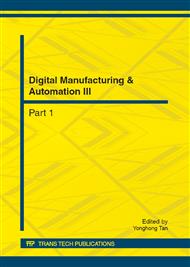[1]
Yan fengming, Kang yili, Li song, et al. Simulated experiment on stress sensitivity in fractured-vuggy reservoir[J]. Natural Gas Geoscience, 2010, 21(3): 489-493, 507. (in Chinese).
Google Scholar
[2]
Li song, Kang yili, Li daqi, et al. ANSYS Simulation of Fracture Width Variation in Fracture-cavity Reservoirs[J]. Natural Gas Geoscience, 2011, 22(2): 340-346. (in Chinese).
Google Scholar
[3]
Kang yili, Yan fengming, You lijun , et al. Loss and control in vugular reservoir formations in block Tahe [J]. Drilling Fluid & Cementing Fluid, 2010, 27(1): 41-43. (in Chinese).
Google Scholar
[4]
Chen shiyi, Kang yili, Ma xuchuan. Application of the screen bridging technology on the new drilling area[J]. Drilling & Production Technology, 2005, 28(6): 99-101. (in Chinese).
Google Scholar
[5]
You lijun, Kang yili, Chen yijian, et al. Application of temporary and shielding plugging technology to improve well logging responses for tight sandstone gas reservoir[J]. Oil Drilling & Production Technology , 2007, 29(1): 113-117.
Google Scholar
[6]
R W. Zimmerman, G S. Bodvarsson. Hydraulic conductivity of rock fractures [J]. Transport in Porous Media 23: 1-30, (1996).
DOI: 10.1007/bf00145263
Google Scholar
[7]
S R. Ogilvie, Evgeny Isakov, Paul W.J. Glover. Fluid flow through rough fractures in rocks. Ⅱ: A new matching model for rough rock fractures[J]. Earth and Planetary Science Letters 241 (2006) 454–465.
DOI: 10.1016/j.epsl.2005.11.041
Google Scholar
[8]
Kang yili, You lijun, Xu xinghua, et al. Practices of Formation Damage Control for Deep Fractured Tight Gas Reservoir in Western Sichuan Basin[C]. SPE: 131323, presented at the CPS/SPE International Oil & Gas Conference and Exhibition in China held in Beijing, China, 8–10 June (2010).
DOI: 10.2118/131323-ms
Google Scholar
[9]
Moghadasi, J. ,Jamialahmadi, M. ,et al. Formation Damage Due to Scale Formation in Porous Media Resulting from Water Injection[C]. SPE: 86524 presented at SPE International Symposium and Exhibition on Formation Damage Control held in Lafayette, Louisiana, 18–20 February (2004).
DOI: 10.2118/86524-ms
Google Scholar
[10]
Natalia Collins, Andrei, Kharitonov, Don Whitfill, et al. Comprehensive Approach to Severe Lost Circulation Problems in Russia[C]. SPE: 135704, presented at the 2010 SPE Russia Oil & Gas Technical Conference and Exhibition held in Moscow, Russia, 26-28 October (2010).
DOI: 10.2118/135704-ru
Google Scholar
[11]
Cui yingchun. A new method for the optimal selection of temporary plugging particles[J]. GEOSCIENCE, 2000, 14(1): 91-94. (in Chinese).
Google Scholar
[12]
Abrams A. Mud design to minimize rock impairment due to particle invasion [J]. JPT, 1977, 29(2): 87-89.
DOI: 10.2118/5713-pa
Google Scholar
[13]
Luo pingya. A Temporary Plugging Techniques on Formation Damage Control during Drilling and Completion. Beijing: Encyclopedia of China Publishing House, 1997: 68~98. (in Chinese).
Google Scholar
[14]
Zhang jinbo, Yan jienian, Zhao haiyan. Optimization of bridging particle size distribution of drilling fluid for formation protection[J]. Drilling Fluid & Cementing Fluid, 2004, 21(5): 4-7. (in Chinese).
Google Scholar
[15]
Liu jing, Kang yili, Liu dawei, et al. Research on the Temporary Shielding Plugging Experiment in Considering Fracture-pore Reservoir of Fracture Width and Pressure Difference[J]. Drilling & Production Technology, 2006, 29(2): 97-98, 101. (in Chinese).
Google Scholar
[16]
Yang jian, Kang yili, Lan lin, et al. Study of Shielding Temporary Plugging Technology for the Fractured Sandstone Reservoir Protection in the Center of Sichuan Basin[J]. Drilling Fluid & Cementing Fluid, 2006, 23(4): 25-27. (in Chinese).
Google Scholar


